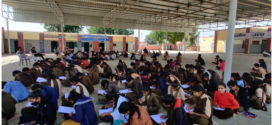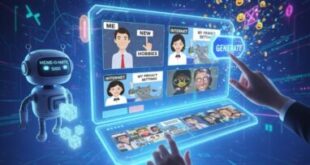The Internet of Things (IoT) is ushering in a new age of unparalleled global connectedness. We can see the size of this change if we look at the numbers. As we delve into the statistics, the sheer magnitude of this transformation becomes evident. With the global population on a constant rise, the number of connected devices has surged exponentially, heralding a new age of interconnectivity. This article explores the current snapshot of IoT’s impact on our lives, the transformative sectors, and the significant changes it brings to the job landscape.
The present world population highlights the enormous potential reach of linked technologies, which stands at 8.1bn. There are 11.7bn connected devices all over the globe, from smartphones and wearables to smart home gadgets and industrial gear. Experts anticipate 75bn linked gadgets in the next five years, which is even more astounding than the projections.
Have you observed the significant surge in the number of connected devices around you, lately? This includes various appliances at home such as your TV, air conditioner, fan, smart lighting, smart locks, and more. Can you recall the last instance when someone from the electricity department came to read your metre?
In the workplace, beyond your computers, have you observed the transformation of various devices like coffee machines, cooling cabinets, surveillance cameras, water pumps, two-wheelers, four-wheelers, and more, into communication devices? The proliferation of connected devices is giving rise to countless applications, extending to even items like jackets, personal protection kits, chairs, and beyond.
Multiple factors cause this surge of linked gadgets. Innovative business applications, Plug & Play IoT modules to integrate with any product, the expansion of wifi sites, improvements in mobile coverage with higher speeds, have all greatly increased people’s ability to access technology. These technological innovations are paving the way for a change in our daily lives, at work, and in our interactions with the world around us, powered by the Internet of Things (IoT).
Major Industry Shifts
The Internet of Things (IoT) is affecting many different areas, and these areas are undergoing transformations that are leading to more creativity, sustainability, and efficiency.
The once futuristic idea of “smart homes” is now a practical reality. You can manage your home’s appliances, security system, and energy consumption like never before with the help of more connected gadgets. Smart Lighting Systems and intelligent Thermostat Control are just a few examples of how the Internet of Things enhances the security, efficiency, and convenience of our homes.
Automobiles with Built-In Network Connections (V2X): V2X communication is quickly gaining popularity in the car industry, allowing vehicles to exchange data with one another and the physical world around them. Along with improving road safety, this paves the way for intelligent traffic management and driverless driving.
In the medical field, wearable sensors and technologies are causing a sea change. Internet of Things (IoT) technologies pave the way for early diagnosis of health problems, individualized treatment programs, and continuous monitoring of vital signs. Not only does this lessen the strain on healthcare systems, but it also improves outcomes.
A smart city aspires to be as efficient as possible in its administration through the internet of things (IoT). Better transportation is guaranteed by smart traffic control, smart lamps reduce energy consumption, data-driven waste management is implemented, and surveillance systems increase safety. Cities that are robust, environmentally friendly, and attentive to their residents’ needs are the end product.
Internet of Things in Industry 4.0: The fourth industrial revolution is defined by using digital technology in production procedures, known as Industry 4.0. The Internet of Things (IoT) allows for more efficient and productive predictive maintenance, real-time monitoring, and data-driven decision-making in several industries.
A New Skill Paradigm and Its Effects on Employment
The widespread adoption of IoT across industries is transforming how we live and work and reshaping the job landscape. The advent of IoT diminishes the need for manual operation of devices, affecting roles in routine work administration maintenance and support. Despite concerns about job losses due to automation, the reality is that as certain jobs decline, new ones emerge. The creation of designs, the development of new products, and the implementation of IoT solutions present a plethora of job opportunities. However, this surge in demand comes with a shift in skill requirements.
In the past, understanding the basics of products sufficed for securing a job. However, integrating technology in various domains necessitates a broader skill set. For example, in the automobile industry, more than the mechanical understanding, professionals need to comprehend how sensors collect data, transmit it to the cloud, and how processing that data enhances efficiency. The connected nature of devices demands a workforce that understands the intricate workings of IoT.
Possibilities for Employment and Necessary Skills
Teams and individuals competent in managing and executing Internet of Things (IoT) projects are essential in smart grids, smart homes, and industrial environments. The national smart grid initiative, which sanctioned 23 crore smart metres, provides a look into the vast deployment that will provide an opportunity for more than 25000 people. Overall IoT ecosystem tend to create millions of job opportunities in the below areas:
1) IOT Hardware – Manufacturing
2) IoT software application development – Software professionals
3) IoT Services – Deployment, Resellers, technicians (maintenance and support of IoT)
4) Cybersecurity – Cyber Security Professionals are in short supply. As the number of connected devices rises, so does the susceptibility to cyber-attacks.
5) IoT Skill – Learning & Development – This creates opportunities for the upskilling of individuals already being exposed to IoT.
Experts in data science and architecture see the massive deluge of information produced by interconnected gadgets. This surge in data necessitates the expertise of data scientists and architects who can analyse and derive meaningful insights. Billions of data points create a need for professionals who can make informed business decisions based on the data deluge.
Moving Forward on the Internet of Things Frontier
As we stand on the edge of a connected future, it’s clear that the Internet of Things has the potential to change everything. The impact is enormous, from connected businesses increasing efficiency to smart homes improving our daily lives. The workforce must be prepared to adapt to the changing labour market and succeed in the Internet of Things (IoT) era. In addition to helping create a smarter, more interconnected society, embracing these changes will open doors to professional opportunities. Innovation, expansion, and a workforce prepared to take on the problems and seize the opportunities of the Internet of Things age await us on the road ahead.
Author: Subburathinam P, Chief Strategy Officer, TeamLease Services Limited
 Newspatrolling.com News cum Content Syndication Portal Online
Newspatrolling.com News cum Content Syndication Portal Online






